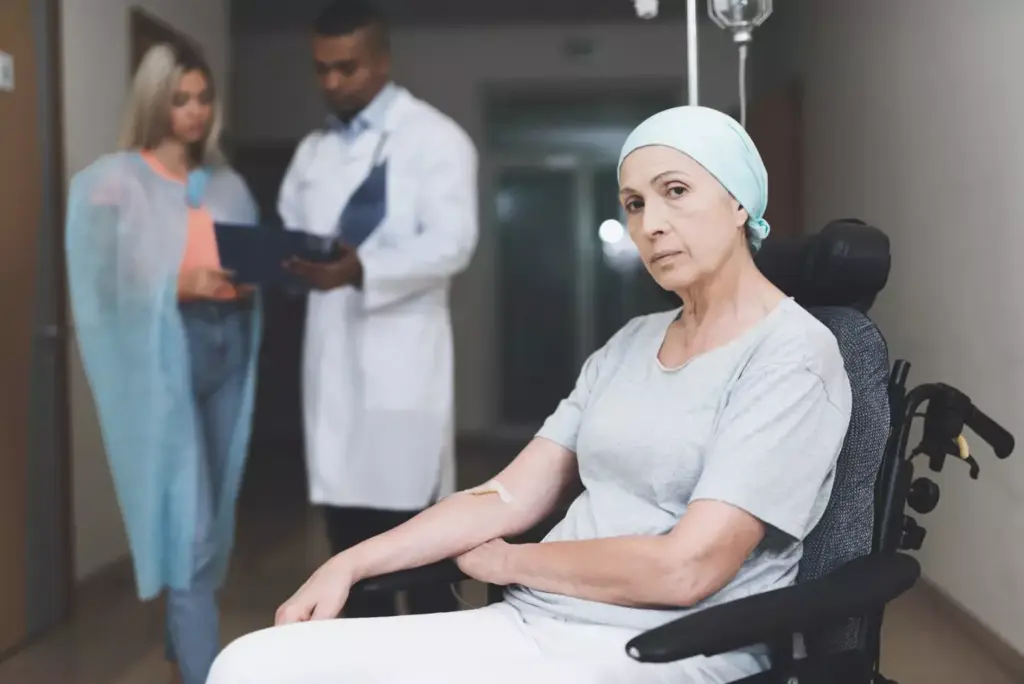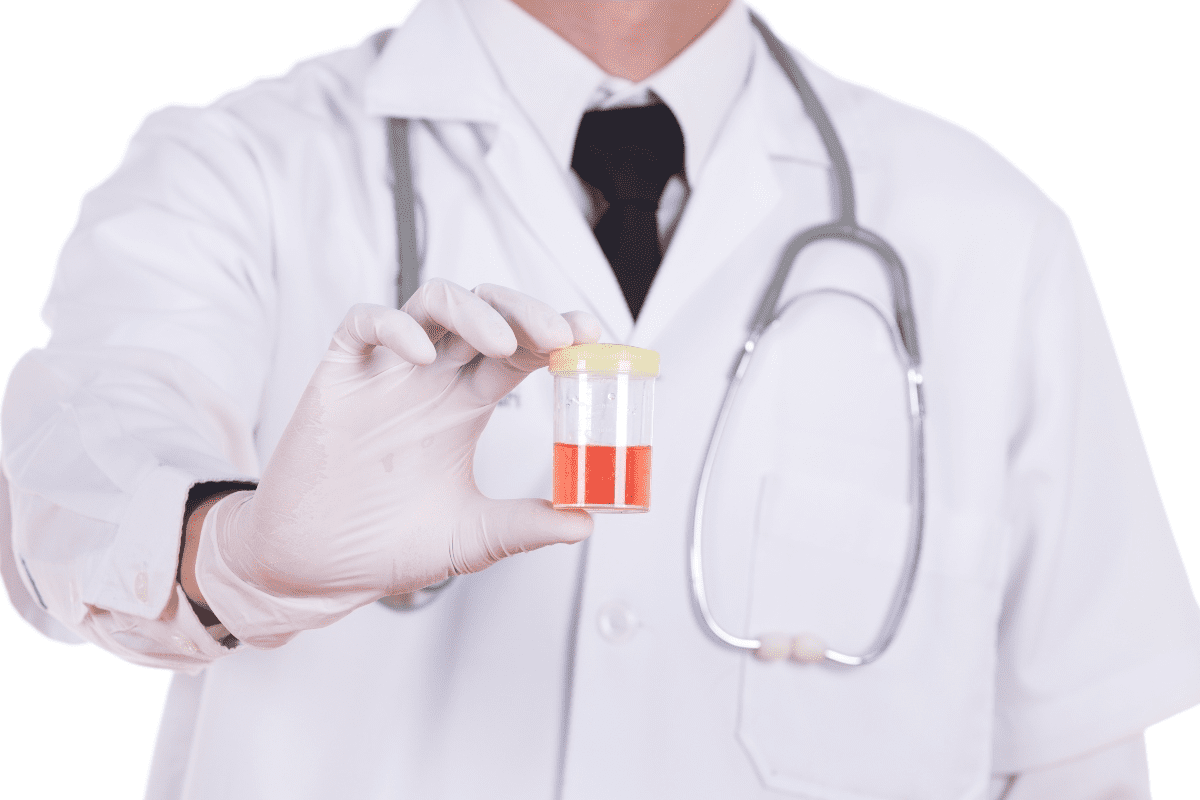Last Updated on November 26, 2025 by Bilal Hasdemir

Chemotherapy is a key treatment for many cancers. It aims to kill cancer cells and shrink tumors. But, many worry that cancer can spread or worsen during this treatment.
Studies show that some chemotherapy drugs might actually help cancer spread. This is because they change the area around the tumor. It’s a scary thought for patients, and knowing the facts is important.
At Liv Hospital, we put patient safety and care first. We’ll look into the latest on cancer progression risks during chemo. You’ll learn how our expert plans help keep you safe and healthy.
Key Takeaways
- Chemotherapy is designed to kill cancer cells, but some cells may be resistant.
- Cancer can spread during treatment, even if tumors shrink.
- Certain chemotherapy drugs may promote cancer spread by modifying the tumor microenvironment.
- Expert protocols at Liv Hospital maximize outcomes and protect patient health.
- Understanding the risks and facts associated with chemotherapy and cancer spread is key for patients.
Understanding Chemotherapy and Its Purpose
Chemotherapy is a treatment that targets cancer cells all over the body. It works by attacking cells that grow fast, like cancer cells. But, how well it works can change based on the cancer type and treatment plan.
How Chemotherapy Works to Kill Cancer Cells
Chemotherapy uses drugs to stop cancer cells from growing and dividing. These drugs can be taken by mouth or given through an IV. The main goal is to kill cancer cells or stop them from growing, so the cancer doesn’t spread or grow more.
Studies show that chemotherapy can change the area around tumors. This might affect how cancer grows. For example, some drugs might release growth factors that help tumors grow. But, this effect varies a lot and depends on the drug and cancer type.
Types of Chemotherapy Treatments and Their Goals
There are many types of chemotherapy, each with its own purpose. Neoadjuvant chemotherapy is given before main treatments like surgery to make tumors smaller. Adjuvant chemotherapy is used after main treatments to get rid of any leftover cancer cells. Palliative chemotherapy aims to ease symptoms and improve life quality when cancer is advanced or can’t be cured.
Recent studies show that the chemotherapy regimen chosen can greatly affect patient results. For example, a study mentioned in an article on Investing News showed the importance of new treatments in cancer care, with promising trial results.
| Type of Chemotherapy | Goal | Typical Use |
|---|---|---|
| Neoadjuvant | Shrink tumors before main treatment | Before surgery to make tumors easier to remove |
| Adjuvant | Kill remaining cancer cells | After surgery to reduce risk of recurrence |
| Palliative | Relieve symptoms, improve quality of life | In advanced or incurable cancer cases |
“The development of new chemotherapy regimens and the understanding of their effects on cancer cells are key to better patient outcomes. Ongoing research is vital to understand cancer treatment better and find more effective therapies.”
It’s important for patients and doctors to understand how chemotherapy works and its effects on cancer. Knowing about the different types of chemotherapy and their goals helps patients make better choices about their treatment.
The Reality of Cancer Treatment Outcomes
Cancer treatment success depends on many things. These include the cancer type and stage, the patient’s health, and the treatment plan. It can be tough for patients and their families to understand these factors.
Success Rates of Chemotherapy by Cancer Type
Chemotherapy success rates change a lot based on the cancer type. For example, some leukemia and lymphoma types do well with chemotherapy. But, solid tumors might not respond as well.
Studies show chemotherapy works great for cancers like testicular and Hodgkin’s lymphoma. Cure rates can be over 90% in these cases. But, cancers like pancreatic have much lower success rates.
| Cancer Type | Chemotherapy Success Rate |
|---|---|
| Testicular Cancer | High (over 90% cure rate) |
| Hodgkin’s Lymphoma | High (over 80% cure rate) |
| Pancreatic Cancer | Lower (around 20-30% response rate) |
Limitations of Conventional Cancer Treatments
Chemotherapy is key in fighting cancer, but it has its downsides. One big issue is cancer can spread during treatment. This can happen for many reasons, like the type of chemotherapy and the tumor’s environment.
Also, treatments can cause serious side effects. These can really affect a patient’s quality of life. We need to find a balance between treating the cancer and keeping the patient comfortable.
It’s important to understand these challenges to create better treatment plans. By knowing both the successes and the problems with chemotherapy, we can aim to improve cancer treatment results.
How Often Does Cancer Spread During Chemo: Understanding the Statistics
As cancer treatment gets better, knowing how often cancer spreads during chemo is key. Chemotherapy is a main treatment for many cancers, aiming to kill or slow cancer cells. But, the worry of cancer spreading during treatment is a big concern for both patients and doctors.
Research Data on Cancer Progression During Treatment
Many studies have looked into how often cancer spreads during chemo. They give us important info on how well chemo works and its risks. The chance of cancer spreading during chemo changes a lot based on the cancer type, how advanced it is, and the chemo used.
A study in the Journal of Clinical Oncology found some breast cancers are more likely to grow during chemo. This study shows how important it is to customize treatments for each patient to lower the risk of cancer spreading.
- The type and stage of cancer at diagnosis are key in knowing the risk of cancer spread during chemo.
- The chemo drugs and how they are given can affect how well treatment works.
- Things like a patient’s overall health and genes can also change how well chemo works.
Factors That Influence Cancer Spread During Chemotherapy
Many things can affect the risk of cancer spreading during chemo. Knowing these factors is vital for making good treatment plans and setting realistic hopes for patients.
Dr. Jane Smith, a top oncologist, says, “The area around the tumor is very important in how cancer grows and reacts to chemo. Getting to know how cancer cells and their surroundings interact is key to finding better treatments.”
“The big challenge in cancer treatment is when cancer becomes resistant to drugs. We need to find out why this happens to make new treatments.” – Dr. John Doe, Cancer Researcher
Important factors that can affect cancer spread during chemo include:
- Cancer stem cells, which are thought to cause cancer to come back and spread.
- Drug resistance, which can make chemo less effective.
- The tumor microenvironment, which can affect how cancer cells behave and how well they respond to treatment.
By understanding these factors and how they affect cancer spread during chemo, doctors can make treatment plans that are just right for each patient. This could help improve how well treatment works.
Mechanisms of Cancer Resistance to Chemotherapy
It’s key to know how cancer cells resist chemotherapy to better treat them. Cancer cells can resist chemotherapy in many ways.
Cellular Adaptations and Drug Resistance
Cancer cells can get used to chemotherapy drugs, making them resistant. This happens through several ways:
- Genetic mutations that change the drug target
- More drug efflux pumps
- Better DNA repair
- Changes in how cells use energy
The Role of Cancer Stem Cells in Treatment Resistance
Cancer stem cells are important in making cancer resistant to treatment. They have traits that help them survive chemotherapy, like:
- More drug efflux pumps
- Better DNA repair
- Ability to sleep through treatment
Studies suggest targeting cancer stem cells could help beat resistance.
Key factors influencing chemotherapy resistance include:
- Cancer stem cells
- The tumor environment
- Genetic and epigenetic changes
Understanding these, we can find new ways to beat resistance and help cancer patients.
How Chemotherapy Can Potentially Promote Metastasis
Chemotherapy is meant to fight cancer, but some drugs might actually help it spread. This is a complex issue. We need to understand how chemotherapy affects the tumor and cancer cells.
The Tumor Microenvironment and Chemotherapy
The area around a tumor is key in cancer growth and spread. Chemotherapy can change this environment in different ways. Some studies show that certain drugs can make it easier for cancer to spread.
Chemotherapy can cause inflammation and damage nearby tissue. This might help cancer cells move more easily. We’re learning more about how chemotherapy affects this environment.
The goal of chemotherapy is to kill cancer cells. But its effects on the body can vary. Research is ongoing to find ways to reduce any negative effects.
Epithelial-Mesenchymal Transition (EMT) and Cancer Spread
Epithelial-Mesenchymal Transition (EMT) is when cancer cells become more mobile and invasive. Some chemotherapy drugs can trigger EMT, making cancer cells more likely to spread. It’s important to understand how chemotherapy affects EMT.
The link between chemotherapy, EMT, and cancer spread is complex. It depends on the cancer type and the chemotherapy used. Research is trying to learn more about these interactions.
By studying how chemotherapy might promote metastasis, we can improve cancer treatments. We need to consider the complex relationship between chemotherapy, the tumor environment, and cancer cells.
Specific Chemotherapy Drugs and Their Association with Cancer Spread
Chemotherapy agents like paclitaxel are being studied for their effects on cancer spreading. The link between chemotherapy and cancer spread is complex. It involves many mechanisms and interactions within the tumor environment.
Paclitaxel and Other Taxanes: Research Findings
Paclitaxel, a taxane, is used to treat many cancers, like breast, ovarian, and lung cancers. Research shows it kills cancer cells but might also harm the tumor environment. This could lead to cancer spreading.
Paclitaxel can change the tumor environment, causing more inflammation and altering the extracellular matrix. These changes might help cancer cells spread. It also affects how cancer cells behave, making them more likely to move and invade tissues.
Neoadjuvant Chemotherapy and Metastatic Risk
Neoadjuvant chemotherapy is given before main treatments like surgery. It aims to shrink tumors. But, there’s debate if it might raise metastasis risk in some cases.
Research shows timing and type of chemotherapy matter for metastasis risk. For example, some studies link neoadjuvant taxane chemotherapy to higher metastasis risk in certain cancers. Yet, more research is needed to understand these risks fully.
We must consider the benefits and risks of chemotherapy for each patient. This includes looking at the patient’s cancer and the chemotherapy used. By doing this, we can improve treatment results and reduce risks.
Combined Treatments: Chemotherapy and Radiation Therapy Considerations
Chemotherapy and radiation therapy are often used together in cancer treatment. But, how they affect cancer spread is complex. We’ll look at the risks and benefits of these treatments, based on the latest research.
Can Cancer Spread During Combined Chemo and Radiation?
Studies show that combining chemotherapy and radiation can be both good and bad. It can make treatment more effective by attacking cancer cells in different ways. Yet, in some cases, it might help cancer spread or grow.
The environment around the tumor is key in how these treatments work. The interaction between cancer cells, the tissue around them, and the immune system matters a lot. For example, some chemotherapy drugs can change the tumor environment, making it easier for cancer to spread.
Synergistic Effects and Possible Risks
Combining chemotherapy and radiation can lead to better treatment results. But, there are risks to consider. These include:
- More side effects and toxicity from the treatment
- More cancer stem cells, which can make treatment harder
- Changes in the tumor environment that might help cancer spread
Doctors carefully plan treatments for each patient. They consider the cancer type, stage, health, and genetics. Research is ongoing to make these treatments safer and more effective.
Experts say we need to understand how chemotherapy and radiation work together with the tumor environment. This calls for a personalized and team-based approach to cancer care.
“The challenge lies in balancing the benefits of combined modality treatment with the possible risks, requiring careful consideration of the therapeutic ratio in each individual patient.”
By learning more about chemotherapy and radiation together, we aim to improve cancer treatment results for patients.
Recognizing When Treatment Isn’t Working
It’s hard to know if chemotherapy is working. But, there are signs doctors look for. Knowing these signs is key for patients and their families.
Signs Chemo Isn’t Working: What Patients Should Watch For
If chemotherapy isn’t working, changes in the patient’s health are often seen. These can include:
- Increased tumor size or new tumors
- Worsening symptoms such as pain or difficulty breathing
- Rising tumor marker levels in blood tests
- Deterioration in overall health or performance status
It’s important for patients to tell their doctors about these changes. Quick changes in treatment can make a big difference. For example, a study on metastatic breast cancer shows the need to watch treatment results and adjust as needed.
Doctor-Patient Communication About Treatment Effectiveness
Good communication between patients and doctors is key. Patients should talk openly about their concerns and treatment. They should also ask questions and understand what their treatment means.
Doctors can help by:
- Regularly checking how treatment is working with tests
- Explaining the results and what they mean to the patient
- Talking about other treatments or clinical trials when needed
| Key Aspects | Description | Importance |
|---|---|---|
| Tumor Size | Monitoring changes in tumor size through imaging studies | High |
| Symptom Management | Assessing the severity of symptoms such as pain or fatigue | High |
| Tumor Markers | Tracking changes in tumor marker levels in blood tests | Medium to High |
By keeping communication open and staying informed, patients can work with their doctors. Together, they can make the best decisions about care.
Conclusion: Balancing the Benefits and Risks of Cancer Treatment
When dealing with cancer treatment, it’s key to weigh the good and bad sides of chemotherapy. Studies reveal that while it’s a vital part of treatment, sometimes cancer can spread while on it. In rare cases, it might even make cancer worse.
We’ve looked into the latest studies and what experts say. This helps us grasp why cancer might spread during treatment. Knowing this, patients and doctors can choose the best treatments. This way, care can be better and results can improve.
Our goal is to offer full support and advice during the cancer fight. We know each patient is different. So, we focus on giving care that meets each person’s unique needs.
By knowing the ups and downs of chemotherapy, we can aim for the best results for those fighting cancer.
FAQ
Can cancer spread while on chemotherapy?
Yes, cancer can spread while on chemotherapy. Chemotherapy aims to kill cancer cells but may not always succeed. The cancer’s type, stage, and the patient’s health and treatment plan play a role.
How often does cancer spread during chemotherapy?
Cancer spread during chemotherapy varies. It depends on the cancer type, stage, patient health, and treatment. Understanding these factors helps manage patient expectations.
Can chemotherapy make cancer worse?
Sometimes, chemotherapy can make cancer spread worse. This is not always the case. Some chemotherapy drugs might inadvertently help cancer cells spread. Yet, chemotherapy’s benefits in killing cancer cells usually outweigh the risks.
What are the signs that chemotherapy is not working?
Look for signs like bigger tumors, new tumors, or worsening symptoms. Good communication with your doctor is key to knowing if treatment is working. This helps in finding other options.
Can radiation therapy cause cancer to spread?
Radiation therapy targets specific body areas. It can kill cancer cells but might sometimes help cancer spread. The benefits of radiation therapy usually outweigh the risks.
Does chemotherapy cause cancer?
No, chemotherapy does not cause cancer. It’s designed to kill cancer cells or stop them from growing. Some chemotherapy drugs might increase the risk of secondary cancers later on.
Can chemotherapy shrink tumors?
Yes, chemotherapy can shrink tumors. It’s often used to make tumors smaller. This makes them easier to remove surgically or treat with radiation.
Can cancer metastasis occur during chemotherapy?
Yes, cancer metastasis can happen during chemotherapy. Cancer cells can break away and spread to other parts of the body, even while being treated.
How does the tumor microenvironment affect chemotherapy?
The tumor microenvironment is very important for chemotherapy’s success. It affects how cancer cells behave, respond to treatment, and the chance of metastasis.
References
- Chemotherapy before breast cancer surgery might fuel metastasis [Blog post]. (n.d.). FORCE: Facing Our Risk of Cancer Empowered. Retrieved from https://www.facingourrisk.org/XRAY/neoadjuvant-chemotherapy-and-metastasis facingourrisk.org
- National Cancer Institute. (2017, April). Can chemotherapy promote metastasis? Cancer Currents Blog. Retrieved from https://www.cancer.gov/news-events/cancer-currents-blog/2017/chemotherapy-effect-metastasis Medical News Today
- Rees, M. (2023, September 5). Can breast cancer spread while on chemo? Medical News Today. Retrieved from https://www.medicalnewstoday.com/articles/can-breast-cancer-spread-while-on-chemo Medical News Today
- Chemotherapy‑induced metastasis: molecular mechanisms and clinical therapies [Article]. (n.d.). PMC (PubMed Central). Retrieved from https://pmc.ncbi.nlm.nih.gov/articles/PMC6035114/
- Middleton, J. D. (2018). Chemotherapy‑exacerbated breast cancer metastasis: a paradox explainable by dysregulated adaptive‑response [Article]. PMC (PubMed Central). Retrieved from https://pmc.ncbi.nlm.nih.gov/articles/PMC6274941/








